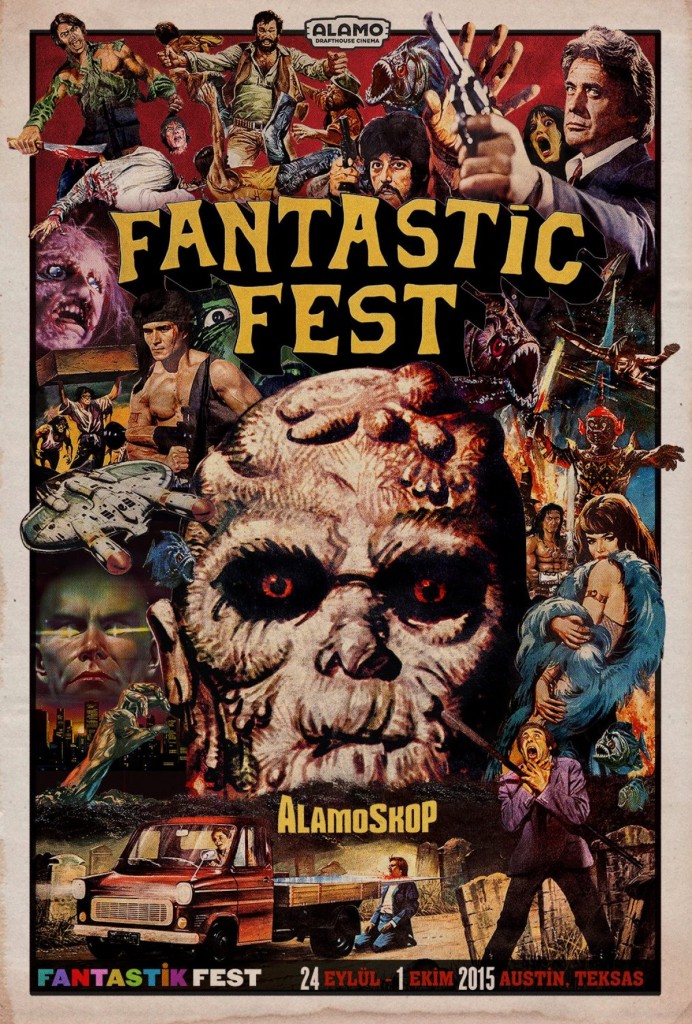
Since I was lazy and did not bother writing up day-by-day dispatches from Fantastic Fest like other, more professional Daily Grindhouse writers, I am only now playing catch up with my festival wrap up. Because this piece ballooned to such a ridiculous length, it will be posted in segments broken up to cover two days at a time. The following is part one.

Dare I begin a piece that is supposed to be about the awesomeness that is Fantastic Fest by complaining about the weather in Austin? Yes, I dare.
After less than 24 hours in Austin, I came to the conclusion that mutants populate Austin, TX. Oh sure, they look like normal people, but they have clearly evolved beyond the rest of the human race to not only survive in the brutal heat and humidity, but also to thrive in it. The side effect of this ability to consider a 95-degree heat index as a cool day is that they all grow beards and magically become covered in tattoos. I should make it clear that this is simply a theory on my part.
This was my first Fantastic Fest and while it seemed slightly chaotic to me, I kept being reassured by veterans of the Fest that things were far more organized than in the past. The massive amount of people milling about — both inside and outside — the Alamo Drafthouse’s South Lamar location made it sometimes hard to get from point A to point B, but no one really seemed to get grumpy about the congestion. The mood, while chaotic to me, was actually laid-back — a trait I have trouble with, since anxiousness is embedded in my DNA.
DAY ONE
Since the first screenings didn’t start until late in the afternoon/early evening, I only managed to get two films in on the first day.
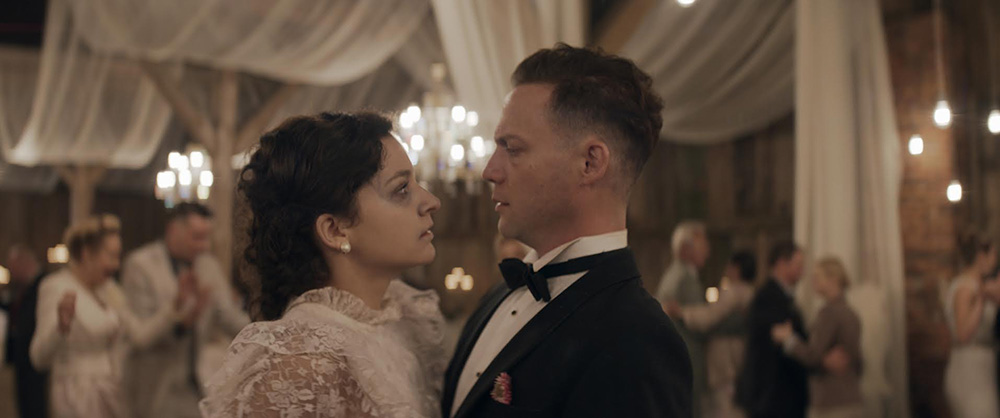
DEMON (2015, Poland) had its North American premiere just a few weeks ago at the Toronto International Film Festival. That premiere was marred by the news that the film’s co-writer/director Marcin Wrona was found dead in his hotel room. That knowledge still hung over the film for me as it began, but I quickly was drawn into the world Wrona created.
Peter (Itay Tiran) is a British architect of Polish descent. Madly in love with his fiancée, Zaneta (Agnieszka Zulewska), he agrees to have their wedding in her hometown in Poland where they also plan to renovate her grandfather’s old summer home as their new house.
Zaneta’s passive-aggressive family immediately puts Peter on the defensive. Her father (Andrzej Grabowski), in particular, does not seem to approve of Zaneta’s decision to marry a man whose first language is English. But Peter does his best to ingratiate himself, promising to design and build a bridge to cross the river that isolates their small town.
With the wedding only a few days away, Peter starts on renovations. His first task of digging a swimming pool is interrupted when he finds a human skeleton several feet down. Instead of calling the police right away, he decides to tell Zaneta and her father of his discovery. But when he sees how excited and happy Zaneta is in her wedding preparations, Peter reburies the skeleton.
What follows is a mixture of black comedy and muddled horror. Working from the idea of the dybbuk — a sort of Jewish possession story — Wrona has Peter start to act… oddly at the wedding. He sees a ghost wandering through the reception, gets spontaneous nosebleeds, and has convulsions that make him spasm on the floor. While Zaneta is terrified and worried for her husband, Her family—especially her father — do everything in their power to keep the reception on track with a steady flow of booze and dancing, while plotting a way to remove Peter from their family as quickly and quietly as possible.
The joke of the film is that Peter’s behavior as a man possessed by a spirit is not any worse or more disruptive than the increasingly drunken wedding guests. Wrona takes full advantage of the chaotic reception to skewer the idea of an insular community that is more concerned with maintaining appearances than figuring out what might be wrong with the clearly suffering Peter—because he is an outsider.
While that wide streak of dark humor works well for the film’s first hour, it eventually overwhelms DEMON in its third act. Wrona loses track of the possession plot thread and indulges too much in the subplot of the family conspiring to break up Peter and Zaneta. While it occasionally hits on the anxiety of marrying into a family that is clearly not on board with the wedding, the chaos and numerous subplots eventually weigh the film down in the third act. The ending is unsatisfying and mean-spirited, nearly erasing all the good will the film built up in its first hour.
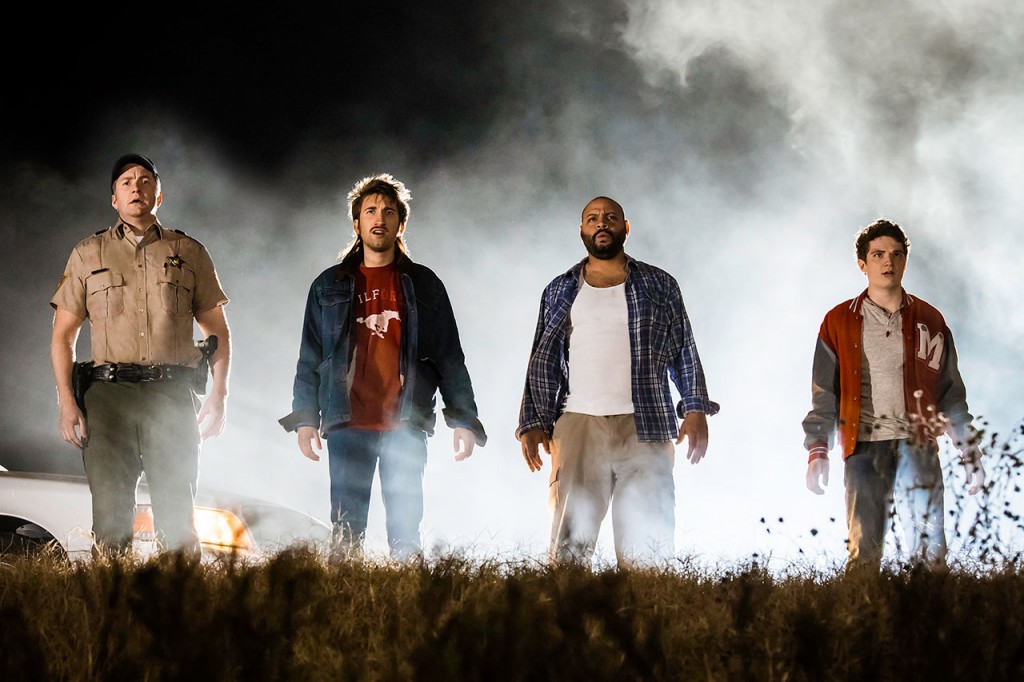
After the downer ending of DEMON, I was looking forward to some laughs courtesy of LAZER TEAM (2015, United States). I was looking in the wrong place.
Intended to be a winking comic throwback to the sci-fi/action films of the ’80s and ’90s, the film is about four morons in a small Texas town who stumble across a super-suit of alien design. After they each put on a part of the suit, they find themselves unable to remove it. Unfortunately for them, the suit was meant for an American super-soldier who is supposed to fight an alien in gladiatorial combat to decide the fate of Earth. Now that they have the suit, the idiots have to learn how to work as a team to save the world.
The film was the brainchild of Rooster Teeth, the comedy production team behind the popular RED VS. BLUE web series. I have never seen any of the series (or anything else the creators have produced), but the Rooster Teeth team is apparently a local Austin favorite, so the audience was stacked in their favor. Even with around 100 people cheering and laughing every twenty seconds, I didn’t find much to like about LAZER TEAM. Without the rooting hometown interest of the other audience members, I simply found the film full of obvious jokes, amateurish performances, and bad special effects. At nearly two hours, it went from simply being bad to an endurance test.
DAY TWO
The second day got off to a much better start with THE GLORIOUS WORKS OF G.F. ZWAEN (2015, Netherlands).
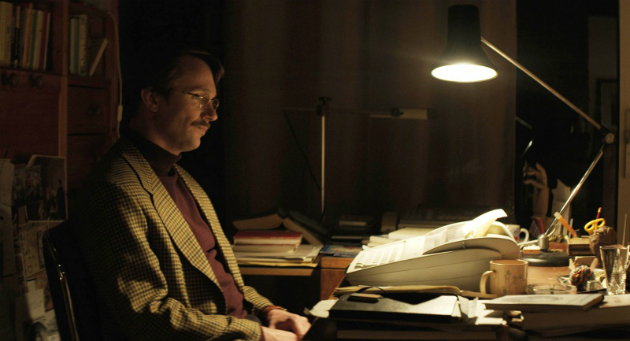
Taking place in the early ’90s, the titular writer (Peter van de Witte) has one novel, a novella, and a handful of short stories to his credit. Despite this small measure of success, Zwaen’s life is slowly spinning out of his control. His rich wife is divorcing him, his new novella is not selling well enough for his publisher to guarantee a second printing, his artist girlfriend seems to be scouting the horizon for a new boyfriend, and he has been reduced to writing biographies of historical figures for children. To top it off, he has also come down with writer’s block.
Despite being put upon, it is not easy to like Zwaen. He is self-pitying, pretentious, and weak-willed. Rather than take any sort of action to recover the life that is slipping away from him, Zwaen rambles on in monologues about how the publishing industry does not understand his genius and is only interested in making money. But Zwaen fails to recognize the hypocrisy of his rants when he then shifts into haranguing his publisher for an unearned advance on work he has failed to do.
When Zwaen stumbles into the aftermath of a murder scene, discovering not only three dead bodies, but also a bag full of money, he makes a very bad decision. Stealing the money, and making an anonymous phone call to the police, Zwaen sets about buying himself a comfortable new life with an expensive apartment and the financial security that allows him to stop writing children’s biographies — or anything else, for that matter.
But Zwaen’s theft puts him in the crosshairs of a thuggish criminal (Michiel Romeyn) and the crooked cop in his pocket (Ton Kas). Lacking the criminal instincts and the experience to know how to deal with such men, Zwaen soon finds himself in over his head as the body count steadily rises and the situation threatens to spin out of the control of everyone involved.
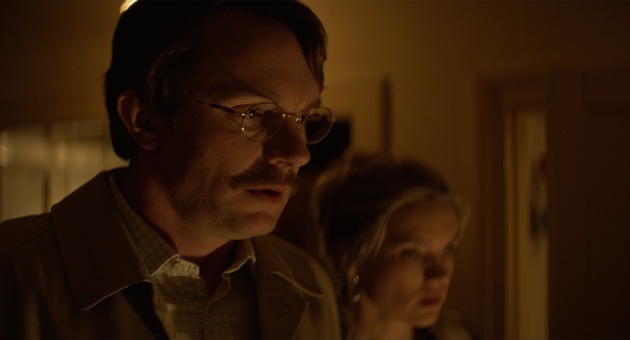
THE GLORIOUS WORKS OF G.F. ZWAEN owes a huge debt to the work of the Coen Brothers. Not only is the plot reminiscent of everything from FARGO to NO COUNTRY FOR OLD MEN, writer/director Max Porcelijn also shows a similar interest in studying what happens when people abandon their morals for financial gain—a theme that becomes more explicit as Zwaen’s monologues twist logic and basic moral principles to fit into a worldview that allows him to keep the money, even as people die.
While the film is derivative to a fault at times, it is still very entertaining. Porcelijn’s script is witty and he provides some dark comic punch lines with his staging of two third act shootouts. Even more importantly, he manages to make the audience care about Zwaen’s plight by allowing him to use his long-dormant skills as a writer to talk his way out of numerous high-stakes situations. It may be familiar material, but THE GLORIOUS WORKS OF G.F. ZWAEN is a lot of fun and worth seeing when it receives distribution.

ANOMALISA (2015, United States) was one of the most anticipated films coming into the Fest this year. A collaboration between writer/director Charlie Kaufman and stop-motion director Duke Johnson, it lived up to the hype.
Michael (voiced by David Thewlis) is a motivational speaker and best-selling writer of a book that has become a de facto bible for customer service departments worldwide. Despite his success, Michael is deeply unhappy. He does not feel any connection—let alone, love—for his wife and son, he obsesses over the girlfriend he dumped for no concrete reason twenty years earlier, and everyone—literally everyone: men, women, and children—he encounters sounds exactly alike, speaking in the same gentle, insistent tone (voiced by Tom Noonan) that grates on his nerves.
On a business trip to Cincinnati to deliver an address to a gathering of customer service managers, Michael impulsively calls his ex-girlfriend who just happens to live in the city. Not surprisingly, the meeting goes disastrously. Dejected, Michael returns to his hotel room. While getting out of the shower, he hears a woman in the hallway speaking in a voice that is not Tom Noonan’s.
Her name is Lisa (voiced by Jennifer Jason Leigh) and she is a huge fan of Michael’s book, in town to hear his speech. Nursing a serious lack of self-esteem due to a scar on the side of her face, Lisa is initially confused by Michael’s attention and almost instant confession of love for her. But his enthusiasm for her voice wins her over and they fall quickly into a romance that is clearly doomed from the start.

While just as melancholy as Kaufman’s other works, ANOMALISA has a little more heart and is not quite as cruel to its characters as past Kaufman efforts have been. Much of this attributable to the presence of Lisa. With an optimistic demeanor that is tempered by her negative experiences with men in the past, Lisa is a refreshingly levelheaded, sympathetic character who is sincere without being corny. She perfectly balances the erratic Michael who comes across as though he may be bi-polar.
The surreal streak that runs through everything Kaufman does is once again on display in the film. Not only does the beautiful stop-motion work give ANOMALISA an off-kilter feel, it lends an odd sort of credibility to scenes where Michael encounters horrifying images or a sequence where he meets the very intense hotel manager. Unlike some Kaufman-penned films, the surreal moments here never feel arbitrary. Instead, they cleverly heighten Michael’s sense of existential despair.
Even though it is a gentler Kaufman tale, the end result is still very bittersweet for all involved. Kaufman repeatedly has returned to the idea that we cannot escape ourselves, no matter how much we might try and ANOMALISA is probably his most distilled version of that theme. It is a beautifully constructed and realized film that deserves a wider audience than it will probably get upon release.

DARLING (2015, United States) was high on my list for this year’s fest for a number of reasons. I loved that writer/director Mickey Keating had talked openly about Polanski’s influence on the film. And the participation of Larry Fessenden’s Glass Eye Pix production company is always a good sign for an indie horror film. But the main reason for my interest was the presence of Lauren Ashley Carter as the titular character. An up-and coming horror performer, I first noticed her in Lucky McKee’s THE WOMAN and then was impressed by her lead performance in JUGFACE two years ago. My initial reaction to the film was positive but a little muted. But it stayed with me as the week went along, gradually getting so far under my skin that I would re-watch it on the last day of the Fest.
Darling (Carter) is the new caretaker of an old Manhattan mansion. In the opening scene, the home’s owner (Sean Young) explains to Darling that it is actually the oldest house in the city. In an exposition dump, she quickly confides — with barely hidden zeal — the tragic story of how the previous caretaker committed suicide by throwing herself off the top floor balcony. After a veiled reference to other stories and rumors that have circulated about the house, she dashes off on vacation, leaving Darling alone in the large, creepy home.
It quickly becomes obvious that Darling is operating under some kind of influence. Whether that influence is mental illness, leftover trauma from an insinuated assault (she has a series of scars on her side), or a sinister force inside the house, it is unclear. And frankly, it does not matter. What does matter is the sense of impending tragedy and the suffocating atmosphere of dread that comes from Mac Fisken’s black and white cinematography and Carter’s large, haunted eyes.

Carter carries DARLING like a veteran movie star. Keating takes full advantage of her delicate face, expressive eyes, petite stature, and spooky presence, putting her front and center for almost every scene. She play Darling as a mousy young woman who alternates long passages of silence with abrupt, straight-forward questions that cut through any bullshit another character may be trying to feed her. Despite Darling’s enigmatic behavior, Carter keeps her sympathetic, knowing when to show the cracks in her aloof façade. Darling’s inevitable descent into madness (possession?) is made all the more heartbreaking and frightening because of Carter’s pitch-perfect performance.
In the Q&A after the film, Keating was very open about the influence of Polanski’s REPULSION on DARLING. While his film initially just feels like a modern remake of that classic, he does much more than replicate Polanski’s style. The jarring sound design, offbeat editing choices, and Carter’s performance help DARLING stand on its own as one of the best horror films I’ve seen this year.

Next up was what turned out to be the best film I saw at the Fest. That it was written and directed by Jeremy Saulnier, who made BLUE RUIN, one of my favorite films of 2014, is no coincidence.
GREEN ROOM (2015, United States) is such a benign title for one of the most visceral, brutal films I’ve seen in years. Equal parts siege film, war film, and survival horror, Saulnier grounds his violent tale in the real world, never giving into any plot point that feels fake.
A young punk band from the Washington D.C. area takes a gig in an out of the way club in the Pacific Northwest. The problem is that the club is owned by Darcy (Patrick Stewart), a white supremacist who employs a number of surly, dangerous skinheads. The band members know better than to willingly put themselves in such a hostile location, but they need the cash for gas money to get back across the country, so they ignore their instincts and play the show. When they stumble across the aftermath of a murder in the titular location, things go from bad to clusterfucked in the blink of an eye.

Trapped in the club by the skinheads who want to kill any and all witnesses to the murder, the band have to figure out a way to fight their way to freedom. Any more description than that would take away from the enjoyment of anyone seeing the film for the first time.
Saulnier builds to the discovery of the murder methodically, but swiftly. He quickly introduces the band members and the various major skinhead characters with brief introductions and then lets the cast fill in the details. Thankfully, the actors playing the band (Anton Yelchin, Alia Shawkat, Joe Cole, and Callum Turner) and the key skinheads (Macon Blair — so brilliant in BLUE RUIN, Mark Webber, Eric Edelstein) commit fully, providing unexpected moments of humor, menace, and conflicted feelings all around. Despite the simplistic logline of “punk band vs. skinheads,” none of the characters feel like caricatures.
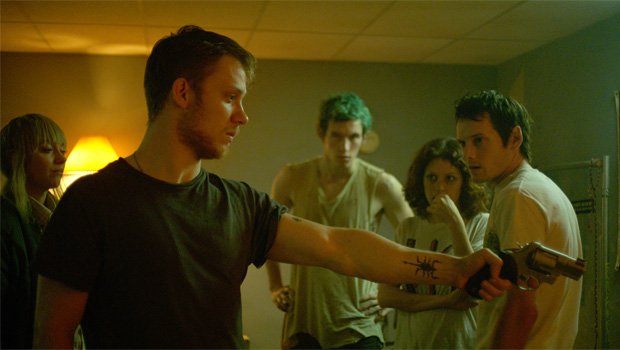
Much like the authentic characterizations, the world of GREEN ROOM feels real — especially to anyone who has spent even a little time in or around a band. The grimy club, the cramped van in which the band travels, tiny apartments where they crash, and restaurants where they play gigs, all look and feel lived-in. Saulnier uses these locations to establish a world that is tangible and familiar, making the bursts of violence that follow come off as even more vicious, brutal, and shocking.
I am hesitant to say any more about GREEN ROOM for fear of giving anything away or building it up to unfair expectations. It is an exciting, sometimes heartbreaking piece of skillfully crafted suspense that left me shaking.

Not surprisingly, after the high of GREEN ROOM, the final film of the day had to feel like a letdown. But even if I had gone into ASSASSINATION CLASSROOM (2015, Japan) with lower expectations, it still would have been disappointing.
An alien that looks like an octopus with a giant smiley face for a head destroys part of the moon and then threatens to destroy the world by the next spring. Military efforts to kill the alien prove useless since he is impervious to all conventional weapons. Eventually, the alien lets the Japanese government know that he wishes to teach a middle school class of misfits while they train to be elite killers with the task of taking destroying the alien using specialized weapons that he actually provides.
Based on the manga of the same name, ASSASSINATION CLASSROOM falls into the same trap of too many manga adaptations. Namely, it tries to stuff six hours worth of material into a running time of less than two hours. Too many characters, subplots, and tonal shifts get in the way of what should be a charming, funny, surprisingly family-friendly story. Perhaps it was the exhaustion I was feeling after spending over fourteen hours in a movie theater, but the film honestly annoyed me with its manic style of storytelling and eventual “to be continued…” ending.
The most frustrating thing about the film is that it has an intriguing premise, touches on class conflict in Japanese society, and offers up a few truly sympathetic and interesting characters. But it largely chucks those elements in exchange for repetitive scenes of the students laying traps for the alien that backfire on them. After forty minutes of this repeated pattern, I was horrified to realize just how much of the film was left to go.

Next up will be a look at days three and four with new films by Ben Wheatley and Joe Begos, a notorious Italian exploitation film from 1972, an assured debut feature, and an unexpectedly fun throwback to action movies of the late ’80s-early ’90s.
— MATT WEDGE.
Tags: Agnieszka Zulewska, Alamo Drafthouse, Alia Shawkat, Andrzej Grabowski, Anton Yelchin, Austin, Charlie Kaufman, David Thewlis, Duke Johnson, Fantastic Fest, Film Festivals, Itay Tiran, japan, Jennifer Jason Leigh, Jeremy Saulnier, Larry Fessenden, Lauren Ashley Carter, Macon Blair, Marcin Wrona, Mark Webber, Matt Wedge, Max Porcelijn, Michiel Romeyn, Mickey Keating, Netherlands, Patrick Stewart, Peter van de Witte, Poland, Screenings, Sean Young, South Lamar, Texas, Tom Noonan, Ton Kas


No Comments